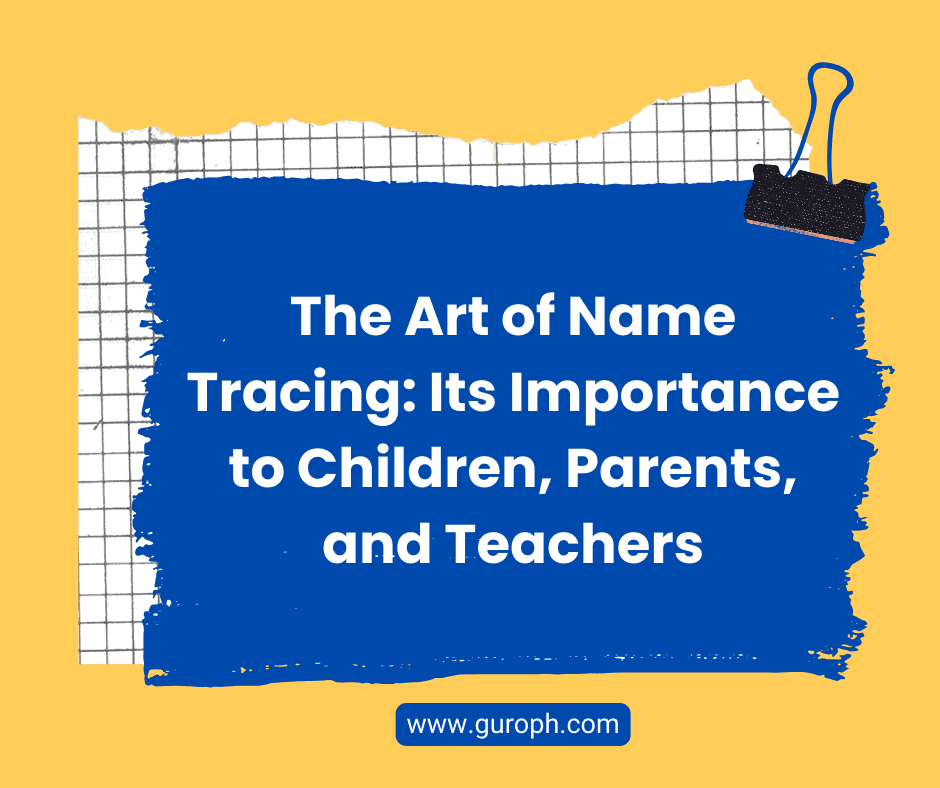Name tracing is a simple yet effective activity that can help young children develop important skills. This activity involves writing a child’s name on a piece of paper and having them trace over the letters with a pencil or crayon. While it may seem like a basic exercise, name tracing can have a significant impact on a child’s early childhood development.
One of the primary benefits of name tracing is that it helps children develop fine motor skills. As they trace over the letters of their name, they practice the small muscle movements that are necessary for writing and other activities. This can help improve their hand-eye coordination and dexterity, which can be beneficial in a variety of areas.
In addition to fine motor skills, name tracing can also help children develop their cognitive skills. As they learn to recognize and write their own name, they are also learning about letters, shapes, and patterns. This can help improve their ability to recognize and remember letters and words, which can be beneficial when they begin learning to read.
Name tracing can also help children develop their social and emotional skills. When children see their names written down, they feel a sense of ownership and pride. This can help boost their self-esteem and confidence, which can be beneficial in all areas of their life. Additionally, name tracing can be a fun and engaging activity that parents and caregivers can do with their children, which can help strengthen the bond between them.
Another benefit of name tracing is that it can help children develop their language skills. As they learn to recognize and write their name, they are also learning about the sounds and meanings of words. This can help improve their vocabulary and language comprehension, which can be beneficial when they begin learning to read and write.
Overall, name tracing is a simple yet effective activity that can have a significant impact on a child’s early childhood development. By helping children develop their fine motor skills, cognitive skills, social and emotional skills, and language skills, name tracing can set them up for success in all areas of their life. Whether done at home or in a classroom setting, name tracing is a valuable activity that parents and caregivers should consider incorporating into their child’s daily routine.
Creative Ways to Incorporate Name Tracing into Your Classroom
Name tracing is a fun and engaging activity that can be incorporated into any classroom setting. It is a great way to help young children learn how to write their names and develop their fine motor skills. There are many creative ways to incorporate name tracing into your classroom, and in this article, we will explore some of the most effective methods.
One of the simplest ways to incorporate name tracing into your classroom is to provide your students with a template of their names. This can be done by printing out a sheet of paper with their name written in large letters or by using a name tag or sticker. Once the template is provided, students can trace over the letters with a pencil or marker. This activity can be done individually or in small groups and can be repeated as often as necessary until the students feel confident in their ability to write their names.
Another effective way to incorporate name tracing into your classroom is to use sensory materials. For example, you can provide your students with a tray of sand or salt and have them trace their names in the material using their fingers. This activity not only helps students develop their fine motor skills but also engages their sense of touch and provides a tactile learning experience.
In addition to using sensory materials, you can also incorporate name tracing into other art activities. For example, you can have your students create a collage of their names using cut-out letters from magazines or newspapers. This activity not only helps students learn how to spell their names but also encourages creativity and artistic expression.
Another creative way to incorporate name tracing into your classroom is to use technology. There are many apps and websites available that allow students to practice tracing their names on a digital device. This activity not only helps students develop their fine motor skills but also introduces them to technology and digital learning.
Finally, you can incorporate name tracing into your classroom by using games and activities. For example, you can play a game of “Name Bingo” where students have to find and trace the letters of their name on a bingo card. You can also create a scavenger hunt where students have to find and trace the letters of their names hidden around the classroom.
In conclusion, name tracing is a fun and engaging activity that can be incorporated into any classroom setting. There are many creative ways to incorporate name tracing into your classroom, including using templates, sensory materials, art activities, technology, and games. By incorporating name tracing into your classroom, you can help your students develop their fine motor skills, learn how to write their name and engage in fun and educational activities.
DIY Name Tracing Activities for Toddlers and Preschoolers
Name tracing is a fun and educational activity that can help toddlers and preschoolers learn how to write their names. It is a great way to introduce them to the world of letters and words, and it can also help them develop their fine motor skills. In this article, we will explore some DIY name tracing activities that you can do with your little ones at home.
The first activity is simple and requires only a few materials. All you need is a piece of paper, a pencil, and some stickers. Start by writing your child’s name in large letters on the paper. Then, have your child place stickers on top of each letter. This will help them learn the shape of each letter and how to spell their name.
Another fun activity is to use playdough to create the letters of your child’s name. Roll out the playdough and use cookie cutters or a knife to cut out the letters. Then, have your child trace the letters with their finger or a pencil. This activity is great for developing fine motor skills and hand-eye coordination.
If you have a chalkboard or a whiteboard at home, you can use it to create a name tracing activity. Write your child’s name on the board and have them trace it with their finger or a chalk or marker. You can also use different colors to make it more fun and engaging.
For a more tactile experience, you can create a name tracing sensory bin. Fill a bin with rice, beans, or sand and bury small letters in it. Then, have your child dig through the bin to find the letters and use them to spell their name. This activity is great for sensory development and can also help with letter recognition.
Finally, you can create a name tracing book for your child. Start by writing their name on the cover of a notebook or a piece of paper. Then, on each page, write their name in large letters and have them trace it with a pencil or a marker. You can also add pictures or stickers to make it more fun and engaging.
In conclusion, name tracing is a great way to introduce toddlers and preschoolers to the world of letters and words. It can help them develop their fine motor skills, hand-eye coordination, and letter recognition. With these DIY name tracing activities, you can make learning fun and engaging for your little ones. So, grab some paper, playdough, stickers, or a sensory bin, and start tracing!
The Importance of Proper Pencil Grip in Name Tracing
Name tracing is an essential skill that children learn in their early years of education. It is a fundamental aspect of their development as it helps them to learn how to write their names and other letters correctly. However, many children struggle with name tracing, and this can be attributed to poor pencil grip. Proper pencil grip is crucial in name tracing as it helps children to write legibly and accurately. In this article, we will discuss the importance of proper pencil grip in name tracing.
Firstly, a proper pencil grip helps children to write with ease and comfort. When children hold their pencils correctly, they can write for longer periods without experiencing fatigue or discomfort. This is because the correct grip allows for a relaxed and natural hand position, which reduces tension in the hand and wrist. As a result, children can write more smoothly and effortlessly, which is essential in name tracing.
Secondly, proper pencil grip promotes good handwriting skills. When children hold their pencils correctly, they can write more accurately and legibly. This is because the correct grip allows for better control of the pencil, which results in neater and more precise writing. Good handwriting skills are crucial in name tracing as it helps children to write their names correctly and legibly, which is essential in their early years of education.
Thirdly, proper pencil grip helps children to develop fine motor skills. Fine motor skills are essential in name tracing as they involve the use of small muscles in the hand and fingers. When children hold their pencils correctly, they use these small muscles, which helps to develop their fine motor skills. This is important as it helps children to perform tasks such as writing, drawing, and cutting with greater precision and accuracy.
Fourthly, proper pencil grip helps children to develop hand-eye coordination. Hand-eye coordination is the ability to coordinate the movements of the hand and eyes. When children hold their pencils correctly, they use their eyes to guide their hand movements, which helps to develop their hand-eye coordination. This is important in name tracing as it helps children to write their names accurately and legibly.
Finally, proper pencil grip helps children to develop good posture. When children hold their pencils correctly, they sit up straight and maintain good posture. This is important as it helps to prevent back pain and other posture-related problems. Good posture is also essential in name tracing as it helps children to write with greater ease and comfort.
In conclusion, a proper pencil grip is crucial in name tracing. It helps children to write with ease and comfort, promotes good handwriting skills, develops fine motor skills, improves hand-eye coordination, and promotes good posture. As such, it is essential that parents and teachers teach children how to hold their pencils correctly from an early age. This will help children to develop the necessary skills and abilities to write their names and other letters accurately and legibly, which is essential in their early years of education.
How to Teach Name Tracing to Children with Learning Disabilities
Name tracing is an essential skill that every child should learn. It is the foundation of writing and helps children develop their fine motor skills. However, teaching name tracing to children with learning disabilities can be challenging. These children may have difficulty with hand-eye coordination, visual perception, and other skills necessary for writing. In this article, we will discuss some tips on how to teach name tracing to children with learning disabilities.
The first step in teaching name tracing to children with learning disabilities is to assess their skills. You need to know what skills they have and what skills they need to develop. You can do this by observing them as they write or by using standardized tests. Once you have identified their strengths and weaknesses, you can tailor your teaching approach to their needs.
The second step is to use multisensory techniques. Children with learning disabilities often learn better when they use multiple senses. For example, you can use sandpaper letters to help them feel the shape of the letters. You can also use textured paper or clay to help them trace the letters. By using multisensory techniques, you can help them develop their fine motor skills and improve their handwriting.
The third step is to break down the task into smaller steps. Children with learning disabilities may become overwhelmed if they are asked to trace their entire names at once. Instead, you can break down the task into smaller steps. For example, you can start by having them trace one letter at a time. Once they have mastered tracing one letter, you can move on to the next letter. By breaking down the task into smaller steps, you can help them build their confidence and improve their skills.
The fourth step is to provide positive reinforcement. Children with learning disabilities may become frustrated or discouraged if they do not see immediate progress. Therefore, it is essential to provide positive reinforcement. You can praise them for their efforts, even if they make mistakes. You can also use rewards, such as stickers or small toys, to motivate them to continue practicing.
The fifth step is to be patient. Teaching name tracing to children with learning disabilities can be a slow process. It may take them longer to develop their skills than other children. Therefore, it is essential to be patient and not rush them. You need to give them time to practice and develop their skills at their own pace.
In conclusion, teaching name tracing to children with learning disabilities can be challenging, but it is not impossible. By assessing their skills, using multisensory techniques, breaking down the task into smaller steps, providing positive reinforcement, and being patient, you can help them develop their fine motor skills and improve their handwriting. Remember that every child is unique, and what works for one child may not work for another. Therefore, it is essential to tailor your teaching approach to their needs and abilities. With patience, persistence, and a positive attitude, you can help them succeed.
More premium learning materials at Education PH, your reliable partner for learning and success. Sa halagang P499/year, makakadownload ka na ng mga premium learning materials para sa iyong anak o estudyante.



Claire Gabriella M. Lingad
ok
Denisse Faith M. Meneses
Dianne Grace M. Meneses